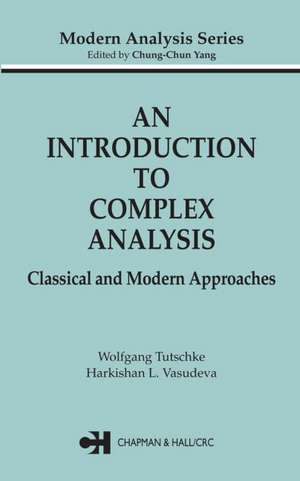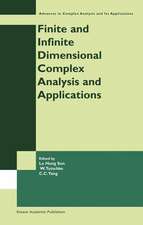An Introduction to Complex Analysis: Classical and Modern Approaches: Modern Analysis Series
Autor Wolfgang Tutschke, Harkrishan L. Vasudevaen Limba Engleză Hardback – 25 iun 2004
To set the groundwork and mitigate the difficulties newcomers often experience, An Introduction to Complex Analysis begins with a complete review of concepts and methods from real analysis, such as metric spaces and the Green-Gauss Integral Formula. The approach leads to brief, clear proofs of basic statements - a distinct advantage for those mainly interested in applications. Alternate approaches, such as Fichera's proof of the Goursat Theorem and Estermann's proof of the Cauchy's Integral Theorem, are also presented for comparison.
Discussions include holomorphic functions, the Weierstrass Convergence Theorem, analytic continuation, isolated singularities, homotopy, Residue theory, conformal mappings, special functions and boundary value problems. More than 200 examples and 150 exercises illustrate the subject matter and make this book an ideal text for university courses on complex analysis, while the comprehensive compilation of theories and succinct proofs make this an excellent volume for reference.
Preț: 774.76 lei
Preț vechi: 1033.60 lei
-25% Nou
Puncte Express: 1162
Preț estimativ în valută:
148.28€ • 154.39$ • 125.31£
148.28€ • 154.39$ • 125.31£
Carte tipărită la comandă
Livrare economică 10-24 martie
Preluare comenzi: 021 569.72.76
Specificații
ISBN-13: 9781584884781
ISBN-10: 1584884789
Pagini: 476
Ilustrații: 52 b/w images and 1000 equations
Dimensiuni: 156 x 234 x 30 mm
Greutate: 1.04 kg
Ediția:New.
Editura: CRC Press
Colecția Chapman and Hall/CRC
Seria Modern Analysis Series
ISBN-10: 1584884789
Pagini: 476
Ilustrații: 52 b/w images and 1000 equations
Dimensiuni: 156 x 234 x 30 mm
Greutate: 1.04 kg
Ediția:New.
Editura: CRC Press
Colecția Chapman and Hall/CRC
Seria Modern Analysis Series
Public țintă
UndergraduateCuprins
Preliminaries. The
Classical Approach. An Alternative Approach. Local Properties. Global Properties. Isolated Singularities. Homotopy. Residue Theory. Applications of Residue Calculus. Mapping Properties. Special Functions. Boundary Value Problems. References.
Classical Approach. An Alternative Approach. Local Properties. Global Properties. Isolated Singularities. Homotopy. Residue Theory. Applications of Residue Calculus. Mapping Properties. Special Functions. Boundary Value Problems. References.
Recenzii
"Many things, which are briefly described in others books, in remarks or exercises, are given in full detail … . [It] will please readers interested … in applications as well as those who want to know how things really work and prefer deeper and more detailed treatment of the material. The book also contains more than 200 examples and 150 exercises. … I recommend it for courses in complex function theory … and also as a reference book."
- EMS Newsletter, Dec. 2004
"… [A]bundant examples and 'hints' to aid readers [are provided]. Summing Up: Recommended. Upper-division undergraduates through professionals."
- CHOICE, March 2005, Vol. 42, No. 07
"For the unification of the structure of mathematical analysis as a whole, it is imperative to use results of real analysis when laying the foundations of complex analysis. This is done in the present book."
-Zentralblatt MATH
- EMS Newsletter, Dec. 2004
"… [A]bundant examples and 'hints' to aid readers [are provided]. Summing Up: Recommended. Upper-division undergraduates through professionals."
- CHOICE, March 2005, Vol. 42, No. 07
"For the unification of the structure of mathematical analysis as a whole, it is imperative to use results of real analysis when laying the foundations of complex analysis. This is done in the present book."
-Zentralblatt MATH
Notă biografică
Wolfgang Tutschke, Harkrishan L. Vasudeva
Descriere
An Introduction to Complex Analysis begins with a complete review of concepts and methods from real analysis that relate to complex analysis, followed by brief, clear proofs of basic statements - a distinct advantage for those mainly interested in applications. Alternate approaches are also presented for comparison. Discussions include holomorphic functions, analytic continuation, isolated singularities, conformal mappings, special functions and boundary value problems. More than 200 examples and 150 exercises illustrate the subject matter and make this book an ideal text for university courses on complex analysis, while the comprehensive compilation of theories and succinct proofs make this an excellent volume for reference.




















